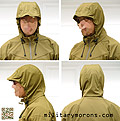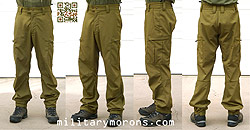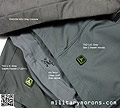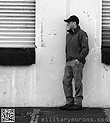Non-Insulated Soft Shells Page 1
Page 2 Page
3 Page 4
As a sizing reference: I'm 5'7", 155 lbs (yeah, I'm a little guy), medium build (BDU top medium/regular, BDU pant medium/short), waist 32", chest 43". Keep this in mind when you read my comments with respect to sizing, so you have an idea of how the garments featured below will fit on you. ALL garments in these pages are size Medium, unless stated otherwise.
TO VIEW FULL SIZE IMAGES: USERNAME and PASSWORD are both "mm"
Group99 L5 Soft Shell Jacket and Pants
| 4/14/12 - The L5 soft shell jacket and pants from the Russian company Group99 are 3-season, lightweight garments intended for mid to high levels of physical exertion. They're water resistant, wind proof, and quick drying.
Gruppa99/Group99 - Group99 LLC is a privately held Russian company that was established in 2011 to design and manufacture gear for Russian SF and law enforcement units. The shareholders and consultants come from different backgrounds; from mountaineering to military consulting. Group99 also teamed up with a U.S.-based design team that included former Patagonia designers. Their products are now sold directly to some SF units and to the general public in Russia and former Soviet Union countries. Clients in the U.S. and other countries can place orders by filling out the form on their website, or by emailing them at info@gruppa99.com. Their website is in Russian, as is their Facebook page, but they're working on bilingual versions of those, as well as their catalog. The garments are made in Asia, and the prices on their website relect the cost of transportation from Asia to Russia, and import duties payable in Russia. As when ordering from countries outside the U.S., additional import duties may be required in the U.S. when ordering. Material - The L5 designation corresponds with the Level 5 (softshell) definition in the SOF-PCU seven-layer system used by the U.S. military. When developing the L5, the design team decided that laminated, fleece-lined shell fabrics aren't breathable enough for high levels of exertion. Starting with about a dozen fabric, they narrowed the fabrics to two styles that were then used to make the first prototypes for testing in the mountains. The fabric finally selected for the L5 set is a double weave ripstop, 226 g/m2, 97%Poly/3% Lycra, with a S-DWR finish to protect from light rain and snow. It has excellent water and wind-resistance, and is very breathable. 'Double weave' is a woven textile in which two or more sets of warps and one or more sets of weft or filling yarns are interconnected to form a two-layered cloth. The inside face has a very soft texture which is very comfortable next to the skin. It's not insulation, but a wicking inside face for comfort and dryness. The exterior is a durable micro rip stop, and was chosen for its resistant to tearing and abrasion. The fabric is made by one of the best mills in Asia which works with major outdoor brands. The colour featured here is 'Russian Khaki'. The closest other colour to it that I have is Arc'teryx LEAF's 'Crocodile' - it looks like a more saturated version of Crocodile. It looks slightly different under different lighting conditions, and is browner under natural light, and sometimes looks slightly bronze under fluorescent lights. I've photograhed it below for comparison under daylight-balanced fluorescent lights with Crye MultiCam and Arc'teryx Crocodile. As always, the first thing I did (as I do with all water-resistant garments) was to line the sink with the L5 jacket and fill it to a depth of about two inches, just to see how water resistant the fabric is. Now, I realize that this is a new garment with new DWR treatment, which will wear over time and slowly lose some of its effectiveness. That's why I leave the garment submerged such that the water pressure can force the water past the DWR into the fabric, and see whether the water penetrates quickly or takes a long time to get saturated. Since I do the same experiment the same way on all garments, it's more of a relative observation. I also rub the water into the fabric, which accelerates the process. The L5 fabric stayed very water resistant until I started rubbing the water into it. It's not as thin as the PCU L5 fabric, but lighter than most other soft shells I've encountered. I'd liken it to one of TAD Gear's older versions of their Stealth jacket made out of 'Shark Skin' material. For such a lightweight fabric, it's very water resistant. It's also very fast drying, and doesn't hold hardly any water. Both the jacket and pant are made of the same material.
L5 Jacket - Here's a summary of the features on the L5 Jacket, size 48/176 (Medium regular) shown:
Observations/Notes - I had never heard of Group99 until they contacted me, and to be honest, was a bit hesitant about reviewing the soft shell set, mainly because it's only available at this time from Russia, and most folks I know here would rather order from the CONUS. But, I've done the same for S.O.D. Gear in Italy, and also considered the fact that many of the visitors to this site are in countries other than the U.S. So, here they are. Group99 also makes a L7 (Level 7) Primaloft insulated 'puffy' suit, but the weather here is too warm now to do any sort of evaluation. Group99's garments are made in China, which is becoming more common nowadays in the tactical market. The issue with making stuff here in the U.S. is cost and skilled labour. Companies might be able to compete on one or the other, but it's very difficult for do it on both, hence overseas manufacturing. TAD Gear had to start manufacturing their soft and hard shells overseas as they couldn't find the manufacturing processes here in the U.S. (and if they did, to get it done at a reasonable cost in low quantities). The new Urban Wolf garments from Arc'teryx are also made in China, and that's from their LEAF line. From the garments I've seen over the years coming out of China, the quality and workmanship is there, as long as the U.S. (or whatever) company provides the correct specifications, and they're adhered to. Ultimately, the final quality control lies with the contracting company, to ensure that the garment is made to spec, to the quality agreed to. While some people still refuse to buy Chinese-manufactured goods, the reason is going to be a philosophical one (which I completely respect), as there aren't any more left to argue against. Overall build quality of the L5 Jacket and Pant is very good - what I'd expect from the higher end overseas-made garments. Definitely superior to the U.S. made SOF-PCU garments, and on par with OTTE Gear, TAD, Massif, VERTX etc. When it comes to some of the design details, there are a couple of things I'd look into changing. The main one is the hood. While I like the separate collar/hood design, the hood itself doesn't provide much coverage. As you can see from the photos, it doesn't cover the face at all; only the head, plus the brim is pretty short. The main issue I have is with the adjustment. The hood was designed with no adjustments in the rear, so that it'd be more comfortable for sleeping. The elastic shock cord pulls are located at the bottom of the neck. So, when I cinch up the cord, all it does is pull the hood down, over my eyes, leaving the rest of the face exposed. The elastic cord running over my fore head bunches the thin material up, and is uncomfortable on my fore head. One solution is to have the shock cord run over a thin stiffener in the brim, over the forehead, so that it doesn't bunch up the material there. Another is to move the location of the shock cord locks higher up, around chin level, instead of at the bottom of the neck. This would allow it to be cinched up a bit more, but not pull it down over the eyes towards the neck. I asked Group99 about this, and they replied that others had mentioned this as well, and they'll look into it. Personally, I feel that if a jacket is going to have a hood, it needs to be fully functional for rain and wind - TAD Gear's soft shell and hardshell hoods, as well as Arc'teryx's hard shells, are prime examples of hoods that provide excellent protection and adjustability. You can cinch them up so that the only opening is the eyes. If I'm going to use something for sleeping, I'd rather keep the eyes exposed, with the rest of the face and neck covered, which the Group99 L5 jacket hood doesn't do. If you're going to use the current Group99 L5 in cold weather or for sleeping, I'd recommend using the hood in conjunction with a neck gaiter. The hood also doesn't stow - it can roll up but there's nothing to keep it rolled up. The other thing I'd like to see would be two-way zippers used for the pit zips, instead of just a one-way zipper. With the one way zipper, you can only open the vent from the elbow. I prefer two-way zippers for pit zips because I can choose the location of where I want the opening (at the bottom, or right at the armpit), in addition to the size. Other than the hood and pit zipper nitpicks, everything else is pretty good to go. I didn't have any other issues with the other functions of the pant or jacket. I wouldn't mind having rear pockets on the pant, but that's just a personal thing. Some folks might prefer having the zippers on the chest pockets located on the outside, vs. towards the center of the chest (Napoleon style). While access is more convenient, reaching across the chest to access the pockets, they're not accessible when wearing a plate carrier or armour. I think what impresses me most about the L5 garments is the fabric. It is supple, breathable and very comfortable. It might be the most comfortable next-to-skin softshell fabric I've run across so far. It's very wind-resistant (which I got a chance to try before wrecking my motorcycle in an accident), and water resistant. Not waterproof like TAD's Stealth hoodie LT fabric, but much more water-resistant than the PCU L5 fabric and some other soft shell fabrics. We had some rain a few weeks ago and I took the opportunity to go outside and walk around in it. When I went out, the rain was 'medium' - more than a drizzle, but not a downpour. I spent about half an hour in it, and I noticed a few drops saturate the fabric and feel damp on the inside - this was on the shoulders/back which take the brunt of the rain. I'd say that it's comparable to other soft shells, Tweave and the Burly double weave that the Drac uses as far as water-resistance goes. I'd put it in the same category as the SOF-PCU L5 suit, Stealth Hoodie LT or Explorer Jackets, Arc'teryx Drac, or OTTE DK Hybrid, rather than the thicker fleece-lined soft shells. It doesn't have the stiffness associated with some of the other single-layer or double-weave soft shell fabrics. Now, given the variety of tactical softshells available in the U.S., why consider ordering from overseas? Price is always a big consideration. The prices on their website are in Roubles. At the time of this writing, the L5 Jacket is priced at 4,800 RUB and the L5 Pant is 3,800 RUB. This translates to $163 USD and $126 USD, which puts them about $100 less than many other tactical soft shell jackets and pants currently available on the market, making them a pretty good value, even with import taxes. If you're interested in looking at Group99's products, go to their website, and click on their catalog .pdf link (they don't have any pics on their site at the time of this writing).
|
| 5/4/12 - The Drac Jacket from Arc'teryx's LEAF division is a soft shell jacket available in their newest colourway - Urban Wolf. Urban Wolf is a medium-grey tone intended for modern urban/industrial environments. Urban Wolf - Arc'teryx's new Urban Wolf series is a much anticipated shade optimized for urban and industrial environments. Traditional dark uniforms stand out against most modern surroundings like concrete, glass, asphalt and rooftops for urban operations. The medium grey tone of Urban Wolf makes one less noticeable in light or shadow, and was developed as a covert tonal shade for law enforcement and special forces, and offers an alternative to the black, green and brown shades common to tactical clothing. Now, those familiar with tactical gear and clothing will know that Triple Aught Design (TAD) has offered their clothing in U.E. (Urban Environment) Grey for years, and EMDOM introduced their SDU Grey nylon back in 2008, for the same reasons Arc'teryx now offers Urban Wolf. Grey makes more sense than black in an urban environment as it stands out less, whether it's in bright or low-light conditions. Now, I'm referring to the colour grey as being a more effective colour when it comes to blending in, and ignoring the 'tactical look' of the garments or equipment made out of it. Just for comparison, I snapped the photo below comparing EMDOM SDU Grey nylon, the Arc'teryx Drac, and two versions of TAD's U.E. Grey. Urban Wolf is lighter than both versions of U.E. Grey, and more neutral than SDU Grey. Whether or not it looks like it has a tint to it depends on the ambient lighting conditions.
The Drac jacket falls between the Combat jacket and Bravo jacket in terms of warmth - the Combat jacket is unlined and uninsulated; the Drac is uninsulated, but has a double-weave soft lining, and the Bravo has a micro fleece lining. 'Drac' is the word for dragon, or devil in several languages. Material - The Drac uses Burly™ double weave in its construction. This is the same fabric used in their Cam SV soft shell gloves. Burly double weave is 46% polyester, 46% nylon and 8% spandex. 'Double weave' is a woven textile in which two or more sets of warps and one or more sets of weft or filling yarns are interconnected to form a two-layered cloth. Most thin softshell fabrics without a fleece inner face are double weave; the thicker ones can be a laminate. The Burly double weave puts the nylon on the outside for durability and the polyester on the inside for moisture management. The spandex adds the stretch. The nylon outer face is smooth, but completely matte. The inside face has a very soft, twill-like texture, with very low nap. It's not insulation, but a wicking inside face for comfort and dryness. The Burly double weave fabric has a DWR coating, and it's quite water resistant, which is to be expected with a fresh DWR. Water beads up on the surface, and it'll hold a pool of water for quite some time before the water eventually makes it through the DWR. Rubbing the submerged fabric will accelerate the water soaking through. The jacket is meant as a water-resistant jacket, not a water proof one, and works well in drizzle, or light showers to medium rain. If it's raining hard, the pressure from heavy raindrops can eventually penetrate, so I'd recommend a hard shell instead. The Drac is available in Urban Wolf (shown here) and Crocodile.
Here's a summary of the features on the Drac Jacket, size Medium shown:
Sizing, fit etc - The Drac Jacket looks to be patterned almost identically to the Bravo and Combat jackets, with the exception that I find it to be roomier , especially around the torso. I measured the Drac bottom hem as 2" longer in circumference than the Combat jacket that I have. There's definitely more room around the waist than either the Combat or Bravo jackets, so it has more of a straight cut 'box' profile, rather than a fitted/tapered profile. This will be welcomed by those who have a bit more robustness around the midriff, prefer a more relaxed fit, or want to use the Drac to conceal a handgun on the waist. Notes and observations - Arc'teryx describes the Drac as a warmer version of the BDU-alternative Combat Jacket. The Combat Jacket was envisioned as a technical alternative to the standard BDU top in cooler conditions, especially when foul weather is to be encountered. But at most, the Combat Jacket can be worn over a thin base layer. The Drac, on the other hand, with its more generous sizing, is more of an outer garment suitable for layering over heavier garments than the Combat Jacket, I feel. So, I see its role as different than that of the Combat Jacket (and Bravo, for that matter). Neither the Combat or Bravo jackets are really suited to CCW as they're so form fitted around the waist and will print whatever's underneath. The Drac fits comfortably over the Atom LT jacket, which is a medium-loft insulating garment; whereas I wouldn't wear much more than a thin base layer under the Combat or Bravo jackets to maintain mobility and comfort. The Drac is great over a lightweight sweatshirt or hoodie, for added water and wind resistance.
The Drac is also advertised as being warmer than the Combat jacket. While the material isn't much thicker, it's the addition of the very thin lining that makes the difference. It's more noticeable after some activity, vs. wearing them on when static. The Drac retains body heat a bit more than the Combat jacket, due to the inner weave trapping air. The Drac lining is also softer against the skin than the unlined Tweave of the Combat jacket. I know that people are going to ask 'which one to get - Bravo, Drac or Combat jacket?' Here's a quick summary of the differences:
Depending on what you want to use the jacket for, I think that the Drac has a bit more versatility than the Combat or Bravo jackets for every day, around-the-town wear. While I love the original Bravo, I wished that it has adjustable cuffs and pit zips, which the Drac has. Because of its roomier fit, the Drac can be used both as a stand-alone jacket or a shell over mid-layers, whereas the Combat and Bravo are too snug to use over insulating layers. Which one fits your needs better depends on your intended usage. I wore the Drac briefly out in the recent rains we had, and it worked well under light drizzle. It's very breathable, but sacrifices some wind resistance for that, so if you're in a cold and very windy environment, you might need a tighter weave than the Drac offers. Where the Drac shines is when there's alternate periods of high and low activity in cool weather, as the breathability and large pit zips allow you to adjust and vent as needed without removing the jacket. The inherent stretch in the fabric also makes it less restrictive than some other shells, and allows full mobility and range of motion when wearing it over or under gear. As far as just for everyday use, Urban Wolf is a good-looking colour, and not as common as black. I don't think the colour itself will make you stand out in a crowd, as the civilian alternative to the Drac is the Gamma LT softshell, which is made of the same material, and is available in 'tungsten', which I think is the same colour as Urban Wolf. The Gamma LT looks to have a slimmer fit around the torso, though, and has only one sleeve pocket, no velcro on the sleeves, pit zips or velcro cuffs, so the Drac (to me) has added versatility and function. Speaking of intended usage, the purpose of the Urban Wolf colour isn't to help you blend into a crowd or walk unnoticed on the street. Anyone familiar with tactical-looking wear or high-end outdoor wear will pick up on the jacket, based solely on its design. It's really intended to help reduce the visual signature of the user (LE or mil), such that they present a less noticeable target, or blend into the surroundings better, while executing an overt mission. Consider a SWAT team deployed to an incident. They're not trying to blend into the crowd, or hide their role as LE officers (the guns and armour usually give it away), but wearing a colour that blends better with the surroundings will make them harder to target, should someone want to take a shot at them. Grey is a practical colour because it doesn't have the same stigma that camouflage patterns have for LE, and in an urban/city environment, it works better than black, OD or ranger green (as far as blending in). I've illustrated it below with some EMDOM gear specially made in their SDU Grey colour, which compliments Urban Wolf quite nicely.
|
ATTENTION! PLEASE DO NOT LINK DIRECTLY TO MY IMAGES
-
IT RESULTS IN MY BANDWIDTH ALLOCATIONS BEING EXCEEDED,
AND MY PAGES GO DOWN. THANKS!
/ . PLEASE
OBSERVE AND RESPECT OUR COPYRIGHT! . /
©opyright by MilitaryMorons.com. All Rights Reserved. Reproduction, Duplication,
Distribution Strictly Prohibited.
Unless mentioned otherwise, content and images are the
property of militarymorons.com and are not in the public domain.
They are not to be used without
permission. Please Contact
me for permission to use any images or content herein.




















































